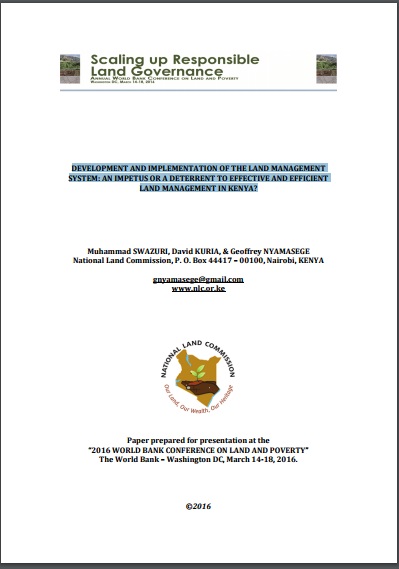Resource information
A Land Information Management System (LIMS) is an information system that enables the capture, management, and analysis of geographically referenced land-related data in order to produce land information for decision-making in land administration and management. The system is a Geospatial Information System (GIS) driven for the purposes of handling and managing parcel based information. The Republic of Kenya, located in East Africa, ranks 33rd in the world in terms of population with 38.6 million people and has a land area of 224,081 square miles. The National Land Information Management System (NLIMS) is special project and it’s a Directorate in the National Land Commission which its sole purpose is to implement, manage and maintain a nationwide Land Information Management System (LIMS) in line with the National Land Commission Act of 2012, section 5 (2) (d), and this will be implemented at both National and County levels. The development and implementation of land information system in Kenya is due to the enactment of the Constitution of Kenya (CoK) of 2010, and the adoption of the Kenya National Land Policy of 2009 which outlines the much sought after reforms in the land sector. The main objective of the project is to enable the development and implementation of an efficient and effective land management system in Kenya in a view to improve services delivery to the people of Kenya. One of the major achievements in the implementation of the LIS would be decentralization of land and natural resources administration and management in Kenya at both the national and county government levels. Once implemented, users will be in a position to sign up for user rights and carry instant searches on the LIS. The system being on its final stages of development, once rolled out, will revolutionize services delivery in the Land sector throughout the country. It will establish an effective and efficient land administration processes, improve the land tenure security which has been a thorny issue and the delivery of basic land services to the citizens of Kenya. It will guarantee accuracy and data security through innovativeness for enhanced provision of land management services, sustainable use of land and natural resources at both the national and county levels. The paper discusses Legal grounding, implementation strategy and the integration framework of the system, work already done/underway and the expectations of this system by Kenyans. Some outstanding challenges and the way forward are highlighted in regards to the reliability of the land management system that is being developed and implemented in Kenya by the National Land Commission.



